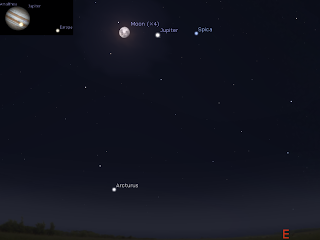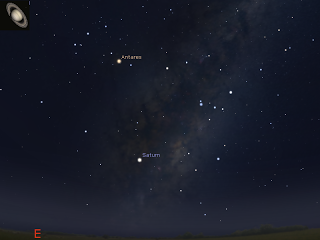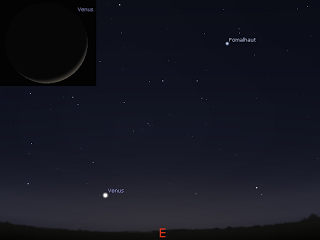

| Online: | |
| Visits: | |
| Stories: |

| Story Views | |
| Now: | |
| Last Hour: | |
| Last 24 Hours: | |
| Total: | |
The Sky This Week – ThursdayApril 6 to Thursday April 13
The Full Moon is Tuesday April 11. Mars is low in the twilight. Jupiter and the bright star Spica are close in the late evening skies, with Jupiter at opposition on the 8th. On the 10th the Moon, Jupiter and Spica form a line, on the 11th the trio form a triangle. Saturn is now visible low in the late evening sky. Venus returns to the morning sky
The Full Moon is Tuesday April 11. The Moon is at apogee, when it is furthest from the Earth, on the 15th.
Evening sky on Saturday April 8 looking west as seen from Adelaide at 18:56 ACST (60 minutes after sunset). Mars is low above the horizon, below Aldebaran.
Similar views will be seen throughout Australia at the equivalent local time (that is 60 minutes after local sunset, click to embiggen).
Mercury is low the evening twilight, but is difficult to see, you will need a clear, unobscured level horizon (like the ocean) to see it.
Mars is in the western evening skies in Aires. It is is low in the dusk sky, but is the brightest object above the western horizon low in the late twilight below Aldebaran.Over the week Mars comes close to the Pleiades cluster, you will need a clear, unobscured level horizon to see this though.
Evening sky on Monday April 10 looking east as seen from Adelaide at 21:00 ACST. Jupiter is above the horizon close to the bright star Spica.The nearly full Moon forms a line with the pair. The inset shows the telescopic view of Jupiter at 21:00 ACST on the 8th with Io and its shadow transiting Jupiter's face.
Similar views will be seen elsewhere in Australia at the equivalent local time. (click to embiggen).
Jupiter is rising at dusk and is now reasonably high above the horizon in the evening this week. It is close to the bright star Spica, the brightest star in the constellation of Virgo.
Opposition, when Jupiter is biggest and brightest as seen from Earth, is on the 8th. Jupiter is rising as the sun sets and is visible all night long. Jupiter is a good telescopic target from around 9 pm on, and the dance of its Moons is visible even in binoculars. The following Jupiter events are in AEST.
Thu 6 Apr 6:11 GRS: Crosses Central Meridian
Thu 6 Apr 20:36 Eur: Shadow Transit Begins S
Thu 6 Apr 20:43 Eur: Transit Begins ST
Thu 6 Apr 23:04 Eur: Sh Ends & Tr Ends
Fri 7 Apr 2:02 GRS: Crosses Central Meridian
Fri 7 Apr 2:29 Io : Shadow Transit Begins S
Fri 7 Apr 2:31 Io : Transit Begins ST
Fri 7 Apr 4:41 Io : Sh Ends & Tr Ends
Fri 7 Apr 21:53 GRS: Crosses Central Meridian
Fri 7 Apr 23:38 Io : Disappears into Eclipse
Sat 8 Apr 1:50 Io : Reappears from Ecl & Occ
Sat 8 Apr 4:31 Gan: Shadow Transit Begins S
Sat 8 Apr 4:43 Gan: Transit Begins ST
Sat 8 Apr 6:45 Gan: Transit Ends S
Sat 8 Apr 20:57 Io : Transit Begins T
Sat 8 Apr 20:58 Io : Shadow Transit Begins ST
Sat 8 Apr 23:07 Io : Transit Ends S
Sat 8 Apr 23:09 Io : Shadow Transit Ends
Sun 9 Apr 3:40 GRS: Crosses Central Meridian
Sun 9 Apr 20:19 Io : Reappears from Eclipse
Sun 9 Apr 23:31 GRS: Crosses Central Meridian
Mon 10 Apr 19:22 GRS: Crosses Central Meridian
Tue 11 Apr 5:18 GRS: Crosses Central Meridian
Tue 11 Apr 18:29 Gan: Disappears into Occultation
Tue 11 Apr 21:03 Gan: Reappears from Eclipse
Wed 12 Apr 1:09 GRS: Crosses Central Meridian
Wed 12 Apr 4:46 Eur: Disappears into Occultation
Wed 12 Apr 21:00 GRS: Crosses Central Meridian
Thu 13 Apr 22:58 Eur: Transit Begins T
Thu 13 Apr 23:12 Eur: Shadow Transit Begins
On the 10th the Moon, Jupiter and Spica form a line, on the 11th the trio form a triangle.
Evening sky on Saturday April 8 looking east as seen from Adelaide at 23:00 ACST. Saturn is just above the horizon.
The inset shows the telescopic view of Saturn at this time. Similar views will be seen elsewhere in Australia at the equivalent local time. (click to embiggen).
Saturn is now visible in the late evening skies this week. Saturn is only a good telescopic target in the morning though. It continues to climb into the evening skys as the week progresses. It is within binocular distance of the Triffid and Lagoon nebula.
The constellation of Scorpio is a good guide to locating Saturn. The distinctive curl of Scorpio is easy to see above the north-eastern horizon, locate the bright red star, Antares, and the look below that towards the horizon, the next bright object is Saturn.
Morning sky on Saturday April 8 looking east as seen from Adelaide at 5:39 ACST (60 minutes before sunrise). The inset shows the telescopic view of Venus at this time.
Similar views will be seen throughout Australia at the equivalent local time (that is 60 minutes after local sunset, click to embiggen).
Venus climbs higher in the morning sky and is visible in telescopes as a thin crescent.
There are lots of interesting things in the sky to view with a telescope. If you don't have a telescope, now is a good time to visit one of your local astronomical societies open nights or the local planetariums.
Printable PDF maps of the Eastern sky at 10 pm AEST, Western sky at 10 pm AEST. For further details and more information on what's up in the sky, see Southern Skywatch.
Cloud cover predictions can be found at SkippySky.
Here is the near-real time satellite view of the clouds (day and night) http://satview.bom.gov.au/
Source: http://astroblogger.blogspot.com/2017/04/the-sky-this-week-thursdayapril-6-to.html






